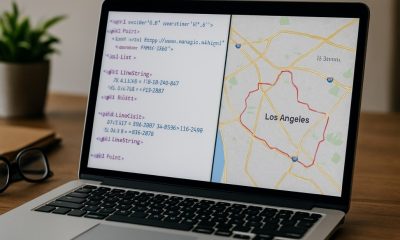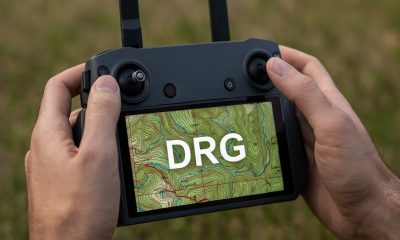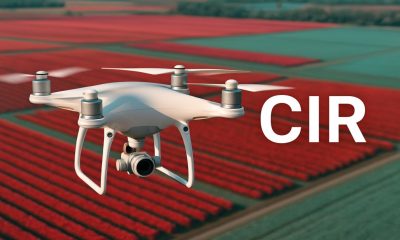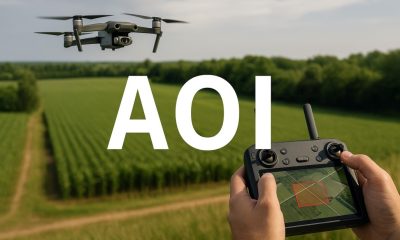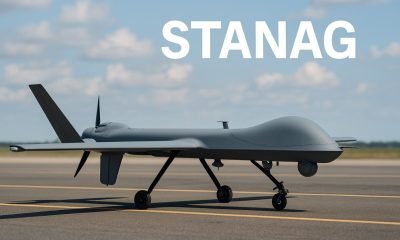- Acronym Guide
- AAM
- ABS
- AC
- ACAS
- ADS-B
- AFAC
- AGL
- AI
- AIM
- ALS
- AM
- AMA
- ANSP
- AOI
- APPI
- AUV
- AUVSI
- ARPAS-UK
- ASTM
- ATC
- BVLOS
- CAA
- CAAC
- CAB
- CASA
- CATT
- CBO
- CBR
- CBRN
- CDMA
- CDR
- CFR
- CIR
- COA
- COMINT
- CORS
- COTP
- COTR
- CPTED
- CV
- C2
- DAA
- DEM
- DFI
- DFS
- DGCA
- DHS
- DOD
- DPA
- DPEs
- DRG
- DRO
- DSM
- DSMX
- DSP
- DSSS
- DTM
- EASA
- EFT
- EO
- EOD
- EO/IR
- ELINT
- EMI
- ESC
- EVLOS
- eVTOLs
- FAA
- FCC
- FCS
- FHSS
- FICCI
- FLIR
- FOB
- FOV
- FPS
- FPV
- GBDAA
- GCP
- GCS
- GDPR
- GML
- GNSS
- GPS
- GSD
- GVC
- HDR
- HOGE
- IACRA
- ICAO
- ICS
- IMU
- INS
- IR
- ISA
- ISR
- ITU
- JARUS
- LAAMS
- LAANC
- LAATM
- LAI
- LBA
- LIDAR
- LOS
- LSALT
- MAC
- MAVLink
- MLIT
- MMS
- MSL
- MTOM
- NDAA
- NCSL
- NFZ
- NIST
- NMEA
- NOTAM
- NPA
- NPRM
- NTIA
- OBIA
- OEM
- OFDM
- OOP
- PASM
- PAV
- PCV
- PdM
- PEC
- PIC
- PID
- PIPL
- PLD
- PM
- PN
- PPK
- PPS
- PSM
- PWM
- UAM
- UAOP
- UAS
- UASTM
- UAV
- UCAVs
- UHD
- UHF
- USV
- UTM
- RAIM
- RCC
- RCS
- RFI
- ReOC
- RePL
- RMS
- ROI
- RPAS
- RPC
- RTH
- RTK
- SaR
- SAR
- SARP
- SBAS
- S.Bus
- SBIR
- SEDENA
- SfM
- SFOC
- SIGINT
- SLAM
- SMS
- SORA
- STANAG
- STTR
- sUAS
- TCAS
- TCCA
- TFR
- TIN
- TOF
- TP
- TPS
- TSA
- VHF
- VLOS
- VTOL
Drone Acronyms
What is GCS (Ground Control Station) & How Does it Work?
By
Jacob StonerTable Of Contents

Definition
GCS stands for Ground Control Station. It refers to the system or interface used by the drone operator to control and monitor the drone during flight. The GCS includes hardware and software components that allow for real-time communication with the drone.
Relevance to the Industry
The GCS is a critical component of drone operations, ensuring that the pilot can effectively control the drone and respond to changing conditions. It is used in applications ranging from commercial drone flights to military missions, offering a centralized interface for managing all aspects of the drone’s performance and mission execution.
How Does a Ground Control Station (GCS) Work?
A Ground Control Station (GCS) is the central hub for managing and controlling unmanned aerial vehicles (UAVs), providing operators with the tools and interfaces needed to command and monitor their missions. Here’s a detailed explanation of how a GCS works:
1. System Components
- Control Interface: Hardware and software used by the operator to control the UAV, typically including joysticks, keyboards, touchscreens, and specialized control panels.
- Communication Links: Data links that facilitate the exchange of information between the GCS and the UAV, including telemetry, control commands, and video feeds.
- Display Screens: Monitors that display real-time data, video feeds, maps, and mission parameters.
- Processing Unit: Computer systems that process incoming data and manage the overall operation of the GCS.
- Antenna System: Facilitates communication with the UAV, including directional and omnidirectional antennas.
2. Communication and Data Exchange
- Command and Control: The GCS sends control commands to the UAV through a secure data link. These commands can include navigation instructions, payload operations, and other mission-specific directives.
- Telemetry Data: The UAV sends telemetry data back to the GCS, providing information on its position, altitude, speed, heading, battery status, and other critical parameters.
- Video Feed: If the UAV is equipped with cameras, the live video feed is transmitted to the GCS, allowing the operator to monitor the UAV’s surroundings and payload activities in real-time.
3. User Interface and Control
- Flight Controls: The operator uses flight controls (joysticks, buttons, touchscreens) to manually control the UAV’s movements, including takeoff, landing, and navigation.
- Autonomous Operations: Many GCS systems support autonomous operations, allowing the operator to pre-program flight paths and mission parameters. The UAV can then execute these commands autonomously while the GCS monitors its progress.
- Mission Planning: The GCS provides tools for mission planning, including route mapping, waypoint setting, and defining areas of interest. These plans can be uploaded to the UAV for autonomous execution.
4. Data Processing and Display
- Real-Time Monitoring: The GCS processes and displays real-time data from the UAV, including telemetry, video feeds, and sensor data. This information is presented on multiple screens or a unified display for easy monitoring.
- Alert Systems: The GCS can generate alerts and notifications for critical events, such as low battery, communication loss, or mission deviations, enabling the operator to take corrective actions.
- Data Logging: Flight data is logged and stored for post-mission analysis, enabling operators to review performance, identify issues, and optimize future missions.
5. Safety and Redundancy
- Fail-Safe Mechanisms: The GCS is equipped with fail-safe mechanisms to handle communication loss or other critical failures. These can include automatic return-to-home (RTH) functions, predefined emergency landing procedures, and redundant communication links.
- Manual Override: Operators can manually override autonomous functions at any time to take direct control of the UAV if necessary.
6. Applications and Use Cases
- Military Operations: GCS systems are extensively used in military applications for reconnaissance, surveillance, and combat operations, allowing for precise control and real-time decision-making.
- Commercial Drone Operations: In industries such as agriculture, construction, and inspection, GCS systems manage UAV missions for tasks like crop monitoring, site surveying, and infrastructure inspection.
- Search and Rescue: GCS systems facilitate search and rescue missions by providing real-time video feeds and telemetry data, enabling operators to coordinate and direct UAVs effectively.
- Scientific Research: GCS systems are used in environmental monitoring, wildlife tracking, and atmospheric studies, allowing researchers to collect and analyze data from remote or hazardous areas.
- Public Safety: Law enforcement and emergency services use GCS systems to manage UAVs for traffic monitoring, disaster response, and public safety operations.
Understanding how a Ground Control Station (GCS) works highlights its critical role in the effective management and control of UAV missions. The integration of real-time data, robust communication links, and user-friendly interfaces makes GCS systems essential for a wide range of applications, from military and commercial operations to public safety and scientific research.
Example in Use
“Using the GCS, the pilot was able to adjust the drone’s flight path in real-time to avoid unexpected obstacles.”
Frequently Asked Questions about GCS (Ground Control Station)
1. What is a GCS in drone operations?
Answer: A GCS (Ground Control Station) in drone operations is the system or interface that allows the pilot to control and monitor the drone. It typically includes a display screen for telemetry data and video feeds, control inputs such as joysticks or touchscreens, and communication systems to send and receive data between the drone and the GCS.
2. How does a GCS benefit drone pilots?
Answer: A GCS benefits drone pilots by:
- Providing Real-Time Control: Allows pilots to input commands and adjust the drone’s flight in real-time.
- Displaying Telemetry Data: Shows essential flight data such as altitude, speed, battery levels, and GPS position.
- Enabling Mission Planning: Facilitates the creation and adjustment of flight plans, including waypoints and automated tasks.
- Enhancing Situational Awareness: Offers a live video feed and other sensory data to help pilots make informed decisions.
3. What are some common features of a GCS?
Answer: Common features of a GCS include:
- Telemetry Display: Real-time data on the drone’s status, including altitude, speed, GPS coordinates, and battery life.
- Video Feed: Live video from the drone’s camera, allowing for visual navigation and inspection.
- Control Inputs: Joysticks, touchscreens, or other input devices to control the drone’s movement and functions.
- Mission Planning Software: Tools for creating, adjusting, and managing flight plans and waypoints.
- Communication Systems: Reliable data links between the drone and the GCS to ensure consistent and secure communication.
For examples of these acronyms visit our Industries page.
As the CEO of Flyeye.io, Jacob Stoner spearheads the company's operations with his extensive expertise in the drone industry. He is a licensed commercial drone operator in Canada, where he frequently conducts drone inspections. Jacob is a highly respected figure within his local drone community, where he indulges his passion for videography during his leisure time. Above all, Jacob's keen interest lies in the potential societal impact of drone technology advancements.


